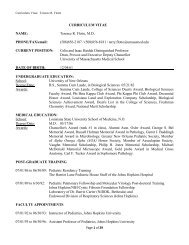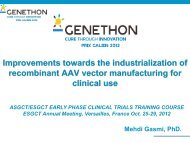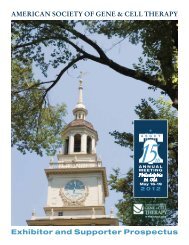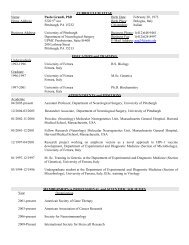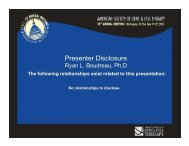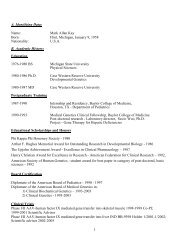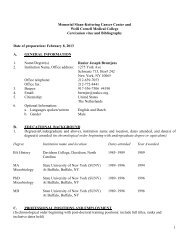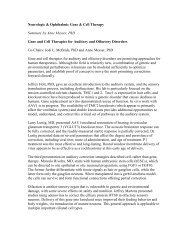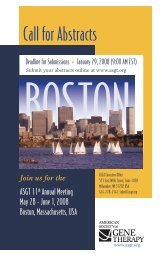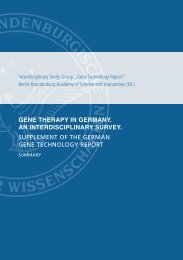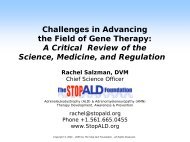13 th AnnUAL MEETing | Washington, DC USA May 19-22, 2010 55Program ScheduleLilia Bi, PhDRecovery and Reduction Costs for <strong>Cell</strong>-based <strong>Gene</strong> <strong>Therapy</strong> ProductsThis presentation will discuss the recovery and reduction costs for cell-based gene therapy products from following aspects:What is the purpose <strong>of</strong> cost recovery and where does it apply?Cost recovery regulations and rulesWhat can be charged for under cost recovery?Process for requesting cost recovery and what information sponsors need to providePotential cost reduction by following the step-wise approach to implementing cGMP’s and product characterizationCarl H. June, MD<strong>Gene</strong>tically Engineered T <strong>Cell</strong>s: Can We Afford Not To Do This?A key concern with adoptive cell transfer therapy is a financial issue related to the potential costs <strong>of</strong> a lymphocyte infusions. Factors that relate to the eventual pricing <strong>of</strong>a personalized therapy consisting <strong>of</strong> autologous T cells are numerous and include issues such as the magnitude <strong>of</strong> efficacy, durability <strong>of</strong> responses, safety and tolerability.In this regard, it is instructive to consider allogeneic stem cell transplantation procedures that have potent efficacy and considerable toxicity, and whether adoptive T celltransfer therapy could supplant and extend this procedure.Jeffrey Schlom, PhDRecombinant Cancer Vaccines as Monotherapy and in Combination <strong>Therapy</strong>Recombinant poxviral vaccines have been developed that contain the transgenes for one or more tumor associated antigens and three T-cell costimulation molecules(TRICOM). Preclinical studies have shown that these vaccines have the ability to break tolerance and induce therapeutic activity in several models. Randomized clinicaltrials in patients with prostate cancer have shown statistical improvements in survival. Preclinical studies have shown that radiation and or chemotherapy can alter the phenotype<strong>of</strong> tumor cells and render them more susceptible to T-cell lysis; combination therapy studies with vaccine are ongoing. Recently results have shown that moleculesinvolved in the Epithelial to Mesenchymal Transition (EMT) metastatic process can be targeted by vaccine therapy.Scientific Symposium 31110:30 am - 12:30 pmRoom: Marriott Ballroom Salon 1Stem <strong>Cell</strong>s and MalignancyChairEvan Y. Snyder, MD, PhD, FAAPSpeakersInder M. Verma, PhDCancer Stem <strong>Cell</strong>s: Lessons from GlioblastomasWe have generated novel mouse models <strong>of</strong> human gliomas using lentiviral vectors containing oncogenes or shRNA to suppressor genes. The resulting tumors had stemcell properties. We will discuss the implications <strong>of</strong> these results.Roger J. Packer, MDChildhood Brain Tumors: Opportunities for Biologic-Based TherapiesBrain tumors are the most common solid malignancy <strong>of</strong> childhood and are the leading cancer related cause <strong>of</strong> morbidity and mortality in the pediatric-aged patients.Progress has been made in the management <strong>of</strong> childhood brain tumors, but lack a clear understanding <strong>of</strong> the molecular pathogenesis <strong>of</strong> these tumors and ways to exploitthis molecular pathogenesis for treatment has slowed progress. Over the past decade, there have been tremendous advances in the understanding <strong>of</strong> the molecularunderpinnings <strong>of</strong> a variety <strong>of</strong> different childhood brain tumors including the most common malignant brain tumor, the medulloblastoma, and the most common benigntumor, the low grade-glioma. Molecular targets have been identified and a host <strong>of</strong> biologic agents including antiangiogenesis drugs, tyrosine kinase growth inhibitors, andagents interfering with intracellular signaling are in clinical trials. To date, their use has not been associated with improvements in survival but there is great enthusiasm incontinuing their study with the hope <strong>of</strong> developing more effective and safer therapies.Friday, May 21 st
56<strong>American</strong> <strong>Society</strong> <strong>of</strong> <strong>Gene</strong> & <strong>Cell</strong> <strong>Therapy</strong>Program ScheduleEvan Y. Snyder, MD, PhD, FAAP“Lineage Mapping” The Development <strong>of</strong> a Brain TumorCarl Bart Rountree, MDThe Role <strong>of</strong> Stem <strong>Cell</strong>s and Cancer Stem <strong>Cell</strong>s in Liver CancerHepatocellular carcinoma (HCC) ranks as the third most frequent cause <strong>of</strong> cancer-related mortality in the world; and over the last four decades, traditional cytotoxicchemotherapy has failed to improve patient survival in HCC. Typically, patients develop HCC after many years <strong>of</strong> chronic liver injury, during which time, there is a significantexpansion <strong>of</strong> the liver stem cell pool. Increasing evidence indicates that liver cancer stem cells (CSC) are the origin <strong>of</strong> a subset <strong>of</strong> HCC, and patients with a CSC phenotypeHCC have a significantly worse prognosis. Additionally, using stem cell surface markers such as CD133, purified liver CSC populations have been identified within humanHCC cell lines and mouse models that mimic human chronic liver injury and HCC development. These liver CSCs are resistant to traditional chemotherapy agents andligand-receptor mediated apoptosis, form tumors at very limited dilution, and represent a critical therapeutic target in future HCC treatments.Friday, May 21 stScientific Symposium 31210:30 am - 12:30 pmRoom: Thurgood Marshall WestCurrent Status <strong>of</strong> <strong>Gene</strong>tic VaccinesChairStephen Gottschalk, MDSpeakersSi-Yi Chen, MD, PhDDC-based Tumor Vaccine by Combining SOCS1 Silencing and TLR SignalingMichael A. Barry, PhD<strong>Gene</strong>-based Vaccines Against Mucosal PathogensThe vast majority <strong>of</strong> pathogens enter the body at mucosal surface. Yet, most vaccine strategies are delivered into the systemic immune system where induced immunologicalmemory may not efficiently “cross-over” to mucosal surfaces to provide barrier protection against these pathogens. To maximize protection, we will discuss comparisons<strong>of</strong> replication-competent and replication-defective first generation and helper-dependent adenoviral vaccines for their utility in systemic and mucosal infections by SHIV,influenza, and methicillin-resistant Staphylococcus Aureus (MRSA). We will also discuss “stealth” strategies during vaccination to evade pre-existing and vector-inducedimmunity against adenovirus including serotype-switching and PEGylation.Sattva S. Neelapu, MDTargeting Chemokine Receptors with Fusion DNA VaccinesTherapeutic vaccination with patient-specific tumor-derived idiotype protein conjugated to a carrier molecule, keyhole limpet hemocyanin and administered with granulocyte-monocytecolony-stimulating factor as an adjuvant was shown to induce tumor-specific immune responses and molecular remissions in follicular lymphoma patientsin phase II clinical trials. Results from a recently completed randomized controlled double-blind phase III trial suggested that administration <strong>of</strong> idiotype protein vaccine inthe setting <strong>of</strong> minimal residual disease improves disease-free survival in patients with follicular lymphoma as compared with control. However, a major limitation <strong>of</strong> thisstrategy is the requirement to generate a custom-made protein vaccine for each patient, by a process that is expensive, laborious, and time-consuming. DNA vaccines maybe produced more rapidly and provide an alternative to protein vaccines. Strategies to enhance the efficacy <strong>of</strong> DNA vaccines by fusing tumor antigens to chemokines andusing novel adjuvants will be discussed.Stephen Gottschalk, MDAdenoviral Vaccines for Enhancing T-cell Therapies for CancerAlthough the benefits <strong>of</strong> T-cell therapy for cancer can be increased by prior lymphodpeletion <strong>of</strong> the host, this process has usually required chemotherapy or radiation.Vaccination with tumor associated antigens to which the transferred T cells respond should be a less toxic means <strong>of</strong> promoting antitumor activity, but to date this hasproved ineffective, favoring instead the transition to a non-cytotoxic immune response. We have developed a new adenoviral based vaccine that contains antigen, atoll-like receptor 5 activator and an inhibitor <strong>of</strong> the antigen presenting attenuator A20. Administration <strong>of</strong> this vaccine prior to T-cell transfer induces a strong Th1-polarizingenvironment leading to potent antitumor effects even in the absence <strong>of</strong> lymphodepletion and even when vaccination or T-cell transfer alone are ineffectual. Such Th1-polarizing vaccines may be <strong>of</strong> value when enhancement and maintenance <strong>of</strong> a Th1 response is desirable.EXHIBITOR PROSPECTUSfinal program
- Page 1 and 2:
FINAL PROGRAMAmerican Society of Ge
- Page 4:
13 th AnnUAL MEETing | Washington,
- Page 7 and 8: 6American Society of Gene & Cell Th
- Page 12 and 13: 13 th AnnUAL MEETing | Washington,
- Page 20 and 21: 13 th AnnUAL MEETing | Washington,
- Page 22 and 23: 13 th AnnUAL MEETing | Washington,
- Page 24 and 25: 13 th AnnUAL MEETing | Washington,
- Page 26 and 27: 13 th AnnUAL MEETing | Washington,
- Page 28 and 29: 13 th AnnUAL MEETing | Washington,
- Page 30 and 31: 13 th AnnUAL MEETing | Washington,
- Page 32 and 33: 13 th AnnUAL MEETing | Washington,
- Page 34 and 35: 13 th AnnUAL MEETing | Washington,
- Page 36 and 37: 13 th AnnUAL MEETing | Washington,
- Page 38 and 39: 13 th AnnUAL MEETing | Washington,
- Page 40 and 41: 13 th AnnUAL MEETing | Washington,
- Page 42 and 43: 13 th AnnUAL MEETing | Washington,
- Page 44 and 45: 13 th AnnUAL MEETing | Washington,
- Page 46 and 47: 13 th AnnUAL MEETing | Washington,
- Page 48 and 49: 13 th AnnUAL MEETing | Washington,
- Page 50 and 51: 13 th AnnUAL MEETing | Washington,
- Page 52 and 53: 13 th AnnUAL MEETing | Washington,
- Page 54 and 55: 13 th AnnUAL MEETing | Washington,
- Page 58 and 59: 13 th AnnUAL MEETing | Washington,
- Page 60 and 61: 13 th AnnUAL MEETing | Washington,
- Page 62 and 63: 13 th AnnUAL MEETing | Washington,
- Page 64 and 65: 13 th AnnUAL MEETing | Washington,
- Page 66 and 67: 13 th AnnUAL MEETing | Washington,
- Page 68 and 69: 13 th AnnUAL MEETing | Washington,
- Page 70 and 71: 13 th AnnUAL MEETing | Washington,
- Page 72 and 73: 13 th AnnUAL MEETing | Washington,
- Page 74 and 75: 13 th AnnUAL MEETing | Washington,
- Page 76 and 77: 13 th AnnUAL MEETing | Washington,
- Page 78 and 79: 13 th AnnUAL MEETing | Washington,
- Page 80 and 81: 13 th AnnUAL MEETing | Washington,
- Page 82 and 83: 13 th AnnUAL MEETing | Washington,
- Page 84 and 85: 13 th AnnUAL MEETing | Washington,
- Page 86 and 87: 13 th AnnUAL MEETing | Washington,
- Page 88 and 89: 13 th AnnUAL MEETing | Washington,
- Page 90 and 91: 13 th AnnUAL MEETing | Washington,
- Page 92 and 93: 13 th AnnUAL MEETing | Washington,
- Page 94 and 95: 13 th AnnUAL MEETing | Washington,
- Page 96 and 97: 13 th AnnUAL MEETing | Washington,
- Page 98 and 99: 13 th AnnUAL MEETing | Washington,
- Page 100 and 101: 13 th AnnUAL MEETing | Washington,
- Page 102 and 103: 13 th AnnUAL MEETing | Washington,
- Page 104 and 105: 13 th AnnUAL MEETing | Washington,
- Page 106 and 107:
13 th AnnUAL MEETing | Washington,
- Page 108 and 109:
13 th AnnUAL MEETing | Washington,
- Page 110 and 111:
13 th AnnUAL MEETing | Washington,
- Page 112 and 113:
13 th AnnUAL MEETing | Washington,
- Page 114 and 115:
13 th AnnUAL MEETing | Washington,
- Page 116 and 117:
13 th AnnUAL MEETing | Washington,
- Page 118 and 119:
13 th AnnUAL MEETing | Washington,
- Page 120 and 121:
13 th AnnUAL MEETing | Washington,
- Page 122 and 123:
13 th AnnUAL MEETing | Washington,
- Page 124 and 125:
13 th AnnUAL MEETing | Washington,
- Page 127 and 128:
126American Society of Gene & Cell
- Page 129 and 130:
128American Society of Gene & Cell
- Page 131 and 132:
130American Society of Gene & Cell
- Page 133 and 134:
132American Society of Gene & Cell
- Page 135 and 136:
134American Society of Gene & Cell
- Page 137 and 138:
136American Society of Gene & Cell
- Page 139 and 140:
138American Society of Gene & Cell
- Page 141 and 142:
140American Society of Gene & Cell
- Page 143 and 144:
142American Society of Gene & Cell
- Page 145 and 146:
144American Society of Gene & Cell
- Page 147 and 148:
146American Society of Gene & Cell
- Page 149 and 150:
148American Society of Gene & Cell
- Page 151 and 152:
150American Society of Gene & Cell
- Page 153 and 154:
152American Society of Gene & Cell
- Page 155 and 156:
154American Society of Gene & Cell
- Page 157 and 158:
156American Society of Gene & Cell
- Page 159 and 160:
158American Society of Gene & Cell
- Page 161 and 162:
160American Society of Gene & Cell
- Page 163 and 164:
162American Society of Gene & Cell
- Page 165 and 166:
164American Society of Gene & Cell
- Page 167 and 168:
166American Society of Gene & Cell
- Page 169 and 170:
168American Society of Gene & Cell
- Page 171 and 172:
170American Society of Gene & Cell
- Page 173 and 174:
172American Society of Gene & Cell
- Page 175 and 176:
174American Society of Gene & Cell
- Page 177 and 178:
176American Society of Gene & Cell
- Page 179 and 180:
178American Society of Gene & Cell
- Page 181 and 182:
180American Society of Gene & Cell
- Page 183 and 184:
182American Society of Gene & Cell
- Page 185 and 186:
184American Society of Gene & Cell
- Page 187 and 188:
186American Society of Gene & Cell



